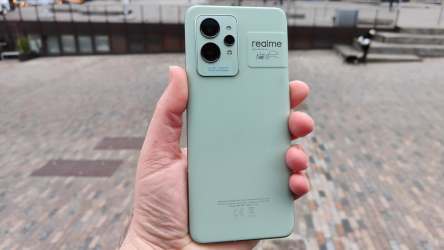
Realme GT 2 Pro Review: Realme’s most powerful and capable smartphone – ever
Realme GT 2 Pro
from £699Pros
- The best flat-2K AMOLED screen you can get
- Flagship CPU and GPU performance
- Great primary cameras and fun microscope lens
- Excellent battery life and power management
- Three years of OS updates
Cons
- Lack of telephoto camera could disappoint
- A few software glitches on review model (hopefully fixed soon)
Is this a sign of Realme moving upmarket? Well, it certainly seems so – but it doesn’t mean the Realme GT 2 Pro has become unaffordable. In fact, it could be the best value flagship on sale anywhere right now.

Since Realme entered the UK market, it has achieved great things by bringing premium features to more affordable phones.
With many different models to choose from, the company offered a variety of choices where you can choose one or two key areas, while accepting a level of compromise in others.
That’s great for consumer choice, keeping pricing down because not everyone wants, needs, or even cares, about every fine detail.
However, for those that do, Realme had the GT line – introduced last year as a replacement for the Realme X series. These were devices that put things like gaming performance at the forefront, at the expense of the cameras that were given more focus (sic) on the Realme number series (such as the Realme 8 Pro).
Now the lines have become a little blurred, as Realme has given the GT series the best-possible camera experience too. The Realme 9 and 9 Pro still perform well, but at a much lower price and with fewer bells and whistles.
I’ll be reviewing the 9 Pro+ and 9i later so you can learn more about them, but for now I’m reviewing the flagship GT 2 Pro (and shortly after the GT 2).

Design & Build
Both GT 2 Pro and GT 2 models come with a choice of paper white or paper green models, each featuring a bio-polymer back design that has the feel of paper to the touch. It’s a bit like last year’s Realme GT 5G with its yellow vegan leather finish, allowing you to go without a protective case if you want – thanks to there being no fragile glass. There’s also no chance of these phones getting smudged with fingerprints.

There is a protective case bundled in the box if you’re not that brave, but the phone also gets Gorilla Glass Victus on the front too (covered with a factory-fitted screen protector). I did the whole review with the phone case-less, and it still looked like new by the end of it.
Even the box the phone comes in is recyclable, and those who buy either model will also have a tree planted in their name – which covers the carbon emissions for the phone’s life cycle (which Realme assumes to be around 24 months).
The signature of Japanese designer, Naoto Fukasawa, is featured on the back, just like last year’s GT Master Edition. It might not be everybody’s cup of tea but it will become a talking point and certainly makes the phone stand out in a crowd.
So too does the solid metal chassis, and a class-leading screen that I’ll mention below. The rest of the phone is standard Realme; power button on the right, volume keys on the left. No 3.5mm headphone jack this time, and a dual SIM tray at the base (with no option of memory card expansion) opposite the downward firing speaker (the second being part of the earpiece on the front).
The SIM tray appears to have a rubber seal that suggests the phone may have some level of water resistance, but it isn’t stated and there’s no official IP certification. I wouldn’t put it to the test, but I am fairly certain it can cope with a few drops of rain without issue.
What you can’t make out, besides seeing the antenna lines on the edges, is that there are 12 antennas positioned around the phone, which switch automatically to get the best mobile reception (4G and 5G) regardless of how you hold the phone. There are enhancements for Wi-Fi too, and even NFC can operate at multiple angles over a larger range.

Display

Another area where Realme has excelled is on the screen, which is a large 6.7-inch 2K (1440×3216 pixel) AMOLED display with 10-bit colour, 1-120Hz adjustable refresh rate (LTPO 2.0), and tiny bezels on all four sides – yes, even the bottom. It’s about equal to the Samsung Galaxy S22 Ultra, but goes without curved edges.
In fact, Realme has made a big deal of the fact that the GT 2 Pro is the first phone to have such a high-quality display that’s also fully flat. Ideal for everyone who gets into a cold sweat when trying to live with a curved display on a day-to-day basis. Flat screens have many advantages, even if curved ones do look more premium.
The display is more power efficient thanks to the adjustable refresh rate, and it also comes with an incredible 1000Hz touch sampling rate. Due to its colour accuracy, it has justifiably won a DisplayMate A+ rating.
Just as I wrote about last year’s flagship, left to its own devices the auto brightness adjustment seems a little too quick to drop to near off (clearly to maximise battery life), and you’ll need to turn it off to fully enjoy the maximum 1400 nits of (peak) brightness in all but the brightest outdoor environments.
You also need to enable HDR mode in the settings to further boost the brightness for suitable content, or if you wish to use the software tools that will enhance images and video.
The fingerprint sensor is embedded in the display, far enough up from the base to make it easy to unlock with a thumb. Or you can use face unlock, for a quicker – if less secure – alternative.

Camera
First up is the great news that this year’s flagship has done away with a 2-megapixel camera, and both the primary wide camera and the secondary ultra-wide camera use highly respectable image sensors, sourced from Sony and Samsung respectively.

The 50-megapixel wide angle Sony IMX766 camera comes with optical image stabilisation, a first for Realme, and it is the same sensor used in countless flagships from last year (e.g. OnePlus 9 Pro and Oppo Find X3 Pro) and even some from this year (e.g. Oppo Find X5 Pro). There’s a reason for this; it’s powerful and works great in low-light conditions.
It supports 10-bit imaging too, although you may find some issues sharing photos in this format (you can re-save as a regular 8-bit JPEG afterwards if this happens). Only Oppo and OnePlus has teamed up with Hasselblad, but the camera interface is remarkably similar.
The secondary ultra-wide camera uses Samsung’s 50-megapixel ISOCELL JN1 sensor, and offers a unique 150-degree Field-of-View that captures almost everything in front of the camera (so much so that you’ll need to be careful not include your fingers!). It also offers a fish-eye mode as an alternative method of using all those pixels.
Last up is a 3-megapixel microlens camera (aka microscope) that works at 20x or 40x for magnified close-ups, just as came as a feature on Oppo’s flagship Find X3 Pro last year. It’s possibly a little gimmicky, and requires a steady hand to use effectively, but it can prove to be quite entertaining, depending on what it is you choose to zoom in on.
You may note the lack of any mention of a telephoto camera, and that’s really the only compromise here. You can get by with 2x zoom using the primary sensor, but once you go to 5x or beyond you will lose detail and risk ending up with photos that lack detail and look washed out.
The saving grace is that you can’t really see the lack of detail on the phone display, and should you be sharing photos on social media, viewed on someone else’s phone, it is quite probable nobody will there either.
This isn’t excusing the lack of something that would have been very welcome, but you can likely get by with the 0.6-2x range for most usage cases. Don’t buy it if you need to do long-distance photography on hiking trips, for example, although I’d suggest the 150-degree mode makes for more exciting landscape photos, with the ability to capture loads of detail from the high-resolution sensor.
When it gets dark, the primary sensor will take advantage of whatever light it can get to produce a very clean, detail-rich, image. It usually does so in around one second or less, but can extend the time as required. The phone can also offer low-light enhancement to video too.
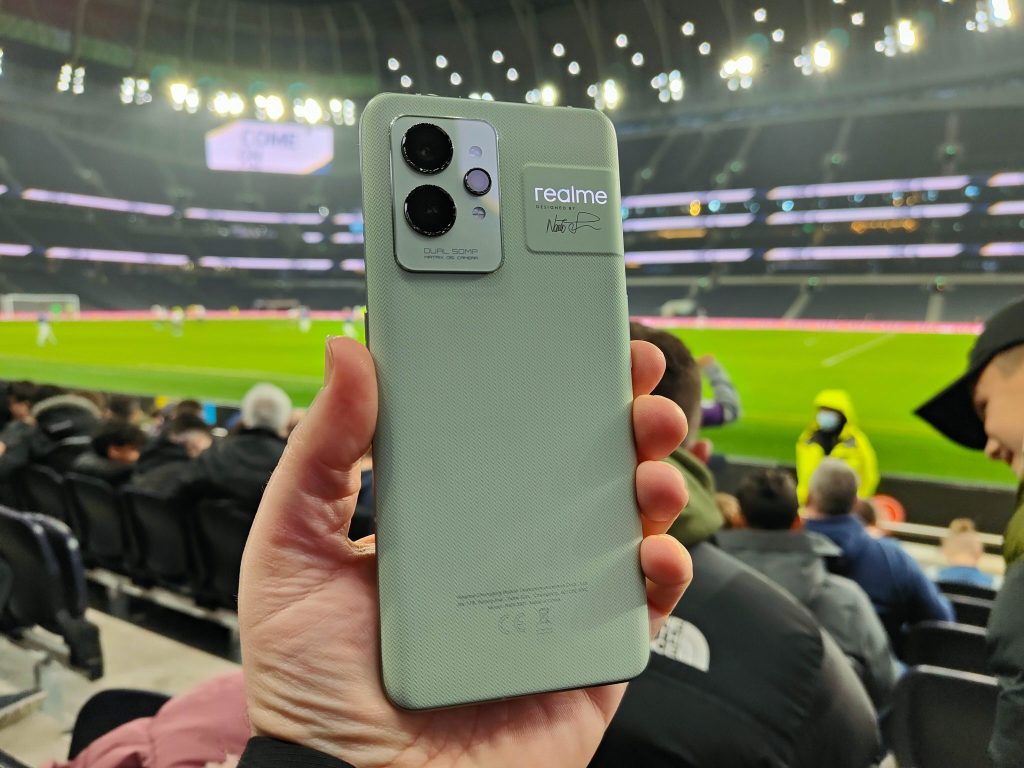
Streetwise
For fast moving scenes, the excellent street mode first seen on the GT Master Edition makes all the necessary adjustments to take sharp photos without shutter-lag (you can fix the focus manually), and it works at different zoom levels. While there’s an even more advanced expert (pro) mode, street mode could become the go-to camera mode for a lot of the people most of the time.
Realme believes in it so much, it’s the default mode when you tap the volume keys to quickly launch the camera from standby.
For video recording, the GT 2 Pro doesn’t scrimp in any avenue either. It can record up to 8K resolution, at 24fps, or 60fps in 4K resolutions and lower. There’s a special Film mode that allows manual control, including HDR and LOG modes. It uses the entire display, and you can toggle the on-screen graphics to get rid of distractions.
There’s a dual-video mode that records using both front and rear cameras, plus a 3D photo mode that can mimic camera tricks like the ‘Hitchcock’ dolly zoom (the best example actually being from Jaws), and more (Swirl, Tango, and Arc). The end result is a fun 3-4 second video clip. You can see some examples below.
The final camera to mention is a 32-megapixel selfie camera, which can also record video at 1080p 30fps.
So, all in all you have an extremely compelling and dynamic set of camera features on offer, with the only thing lacking being a powerful zoom capability. As you can see below, it doesn’t impact too badly on the versatility of the phone.
Photo Gallery





Street Photo



Ultra-wide (150 degree)









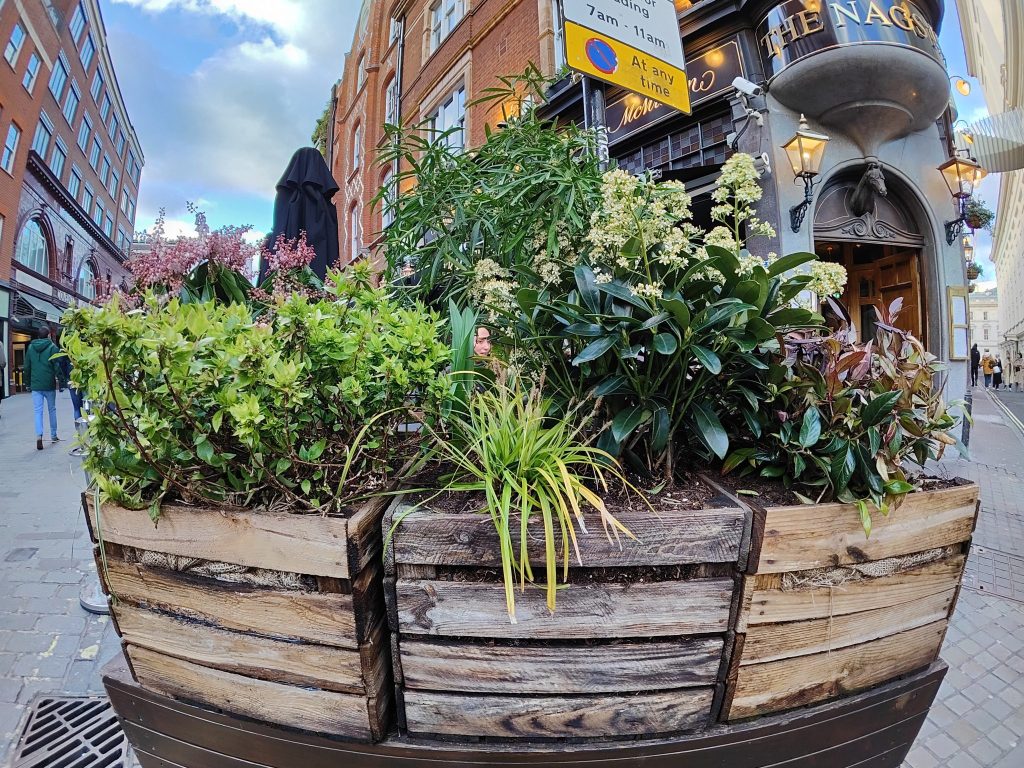

Portrait



Zoom
From the 150-degree camera to 20x digital zoom











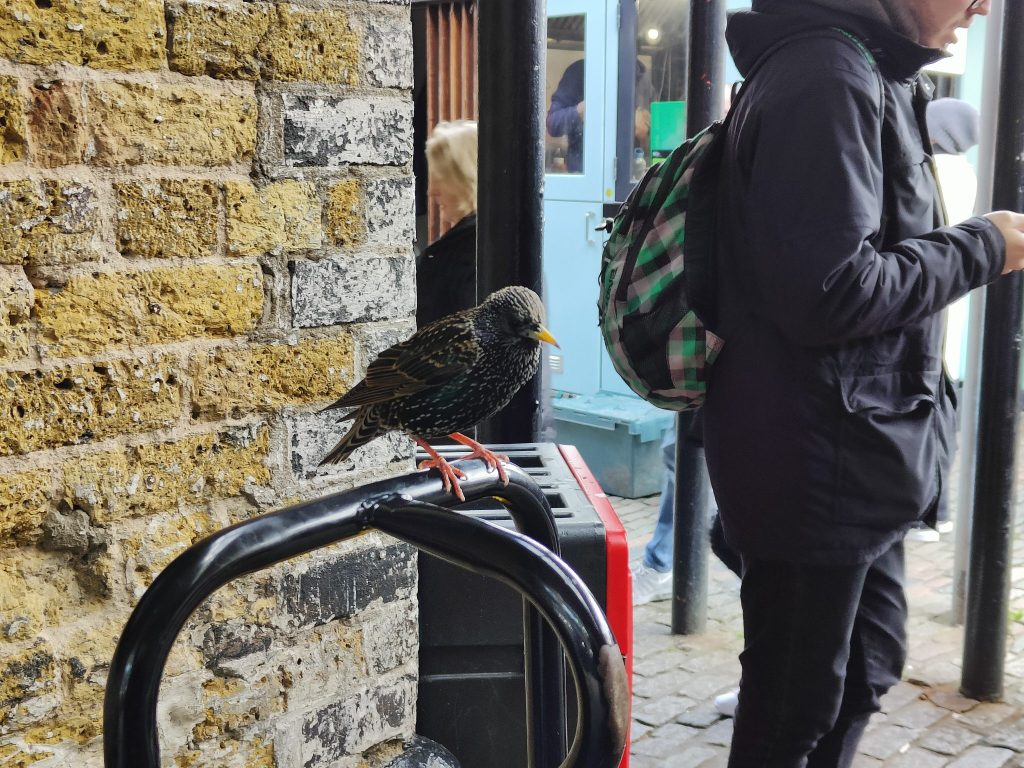











Food

Selfie

Microlens






Video
Performance & Battery
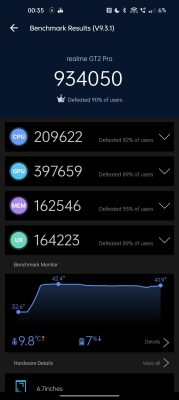
Realme has once again hit the ground running with the performance capabilities of the GT 2 Pro, with Qualcomm’s top-end Snapdragon 8 gen 1 chipset that Realme showed getting an impressive 1 million+ score on AnTuTu (although when I tried the same benchmarking app on my phone, I couldn’t get beyond 934,050). Still mighty impressive, and conducted using Realme’s GT performance mode that ramps up everything to the max.
The phone has advanced cooling, to reduce thermal throttling, and this is perhaps where Realme managed to eke out more performance by doing the test in a cooler environment. I did the test indoors, with around 21 degrees ambient temperature and 50% humidity.
The GT mode also allows you to fix the screen refresh rate to 120Hz, as well as boosting the touch sensitivity, hide notifications and other settings.
Turn it up to 11

If putting the phone into maximum performance leaves you concerned about battery life, be reassured that the phone has a 5,000mAh battery with 65W fast-charging to make it quick and easy to recharge when the power does drop. There’s no wireless charging support, just in case you were hoping Realme hadn’t made any compromises at all!
There are two different power saving modes, with the super power saving mode turning off almost all background tasks to potentially double standby time. I stuck to the standard power saving mode for days out where I wanted to try and last the entire day, using the camera heavily and keeping things like 5G active.
I limited the screen brightness, but kept background apps running so as to continue receiving notifications. I also kept the screen running at (up to) 120Hz.
You can pretty much adjust everything to suit your needs at any given time. If you’re not worried about battery life then you can simply leave everything running, and the phone feels every bit as quick and nimble as flagships costing hundreds of pounds more – but don’t be surprised when the screen on time drops to around three hours for anything but basic web browsing or media consumption.
The GT 2 Pro has Wi-Fi 6 like previous models, but with 5G offering the potential for huge speeds, you also need fast connection speeds if you want to share that speed with other devices. The GT 2 Pro can be set up as a personal hotspot with speeds up to 2400Mbps, which is quite incredible (naturally, you’ll need to connect a device that supports such speeds, given most are limited to 1200Mbps, but that’s good for further future proofing).







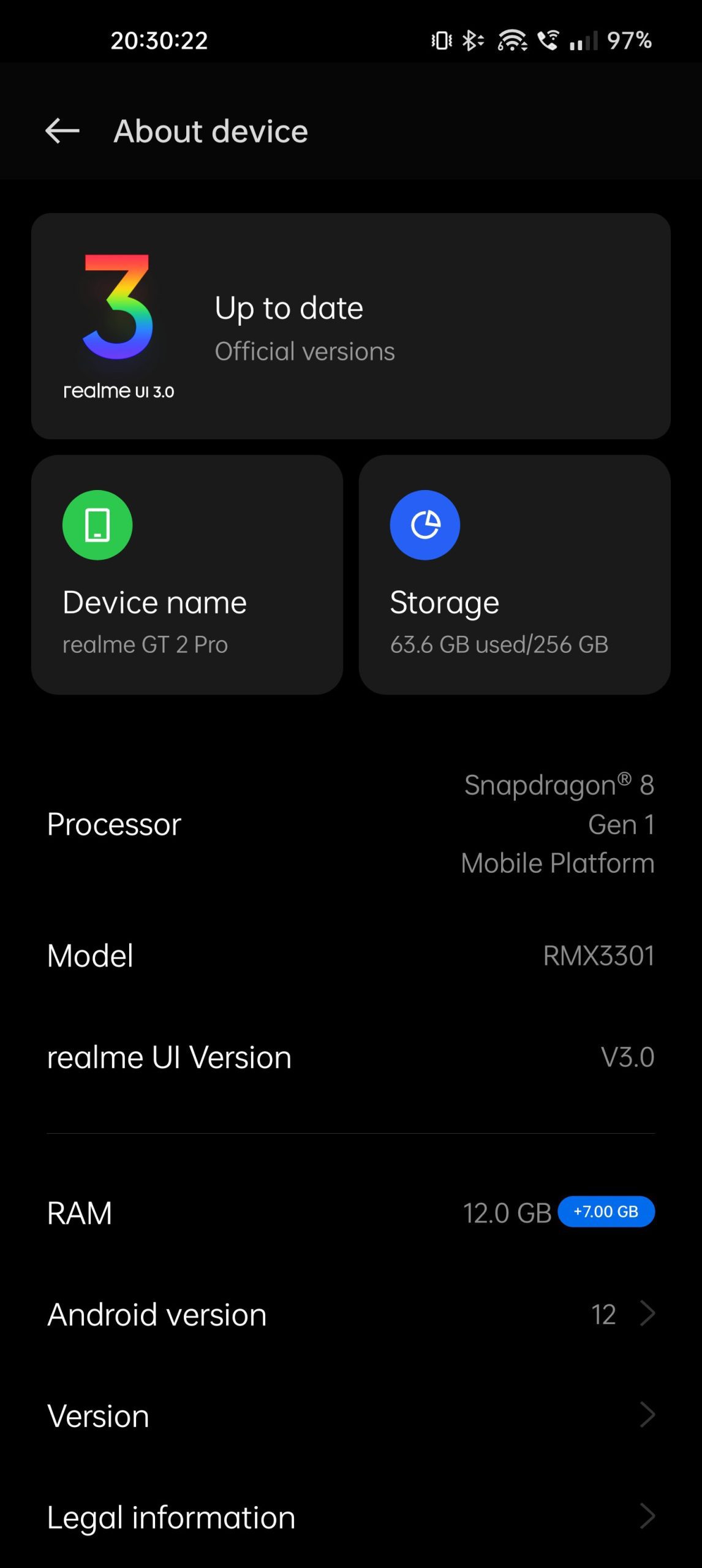

Another new feature is dual Wi-Fi acceleration, which can aggregate data from two different Wi-Fi networks. Not all apps support this, and I’d argue the ones that do really don’t need access to superfast data, but the list is likely to grow as time goes on.

Finally, within the Labs menu you’ll find a heart rate monitor that uses the fingerprint sensor, and a link to PC-Connect; software for a Windows PC that lets you sync notifications, transfer files and your clipboard with ease.
The phone comes with Android 12 (Realme UI 3.0) and I did encounter some weird oddities on the review model, from issues with Android Auto (fixed by entering developer settings and changing the DPI), a weird issue with the power button not shutting down the phone, and audio blasting out of the phone speaker when disconnecting a Bluetooth audio device (normally, audio should pause automatically).
Realme has assured me that this will all be addressed with an additional update on or soon after its release (from March 8th).
An issue with Google Pay not working was already been fixed during my review period, as the software has gained Google certification. However, Netflix was still not available to download at the time of writing. You can sideload it from an APK store, but it only supports HD playback – not HDR. Again, this will be hopefully fixed soon.
Overall
Last year’s flagship was quite difficult to get hold of, but that’s not the case this time around. You can get the phone from Currys or Amazon, making it far more accessible. Realme still needs to work on getting carrier support, so you can buy the phone on a contract, but smart buyers will realise the benefit of separating phone and SIM, with SIM only deals being a great way to reduce monthly expenditure, as well as beating annual price rises (simply port out and back in to a new deal if you can).
Of course, this means paying more up front – but there are clear savings to be made, especially if you intend to keep the phone for two or three years.
That leads to other good news, as Realme has committed to three years of Android OS updates (and four years of security updates).
At £699, the Realme GT 2 Pro is excellent value – and with the initial early bird discount taking this down to £599 (for sales before March 14th), it becomes a steal.
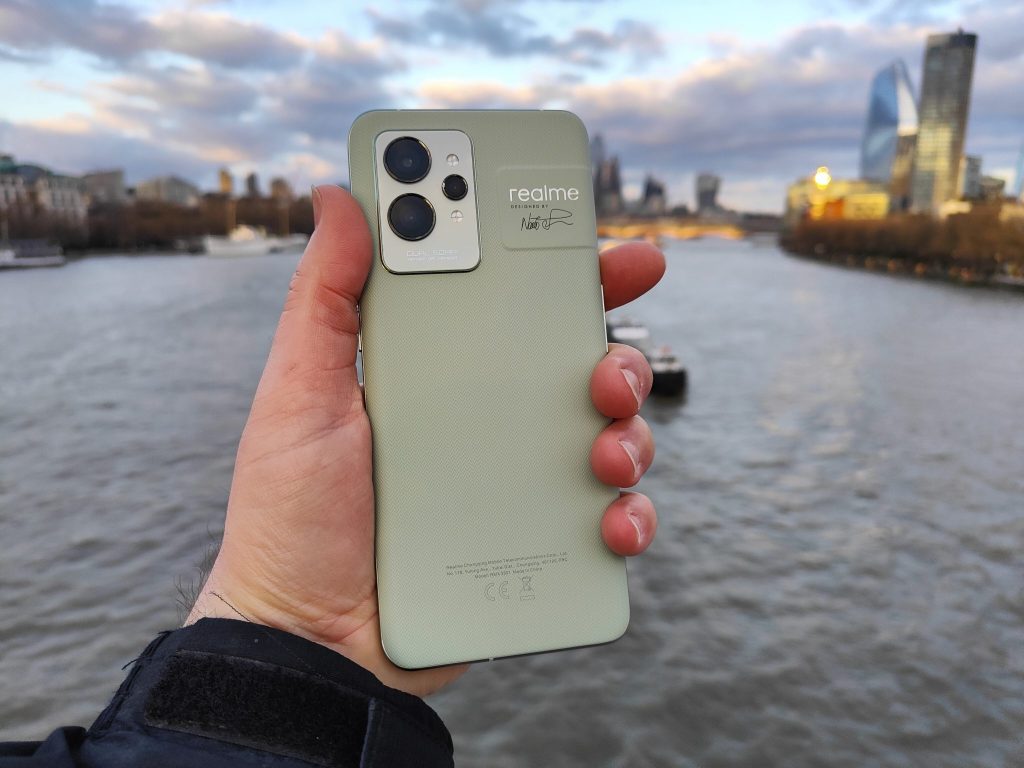
Key Specifications
| Realme GT 2 Pro | |
| Size/Weight | 163.2×74.7×8.2mm (189g) |
| Screen | 6.7-inch AMOLED (flat) 2K 1440×3216 pixels ‘Super reality Display’ 10 bit colour (1 billion colours) 1400 nits peak brightness 120Hz refresh rate (LTPO 2.0 1-120Hz), 1000Hz touch sampling rate |
| Audio | Dolby Atmos Stereo Sound |
| Chipset | Qualcomm Snapdragon 8 gen 1 (4nm) Max freq 3GHz Adreno 730 GPU |
| RAM | 8GB or 12GB LPDDR5 Quad Chanel (plus virtual memory, up to 7GB) |
| Storage | 128GB or 256GB UFS 3.1 |
| Camera (front) | Punch-hole 32MP Fixed Focus (f/2.4) Video: 1080p 30fps with EIS |
| Camera (rear) | Primary: 50MP (f/1.8) Sony IMX766 (1-5x Zoom) Ultra-wide: 50MP (f/2.2) Samsung JN1 (150 degree FoV) Microlens: 3MP (f/3.3) (20 or 40x microscope mode, with illumination) Video: Max 8K/24, 4K/120 with OIS and EIS including 10bit video |
| Connectivity | Dual band Wi-Fi 6 (802.11ax) 5G NR (SA & NSA) Sub 6 4G+ with VoLTE, ViLTE and VoWiFi Bluetooth 5.2 LE NFC USB-C |
| Battery | 5,000mAh 65W fast-charging (wired, and supplied in box) |
| Other | Bio-polymer rear panel Protective case Factory fitted screen protector Dual SIM (Dual Standby) Stainless Steel Vapour Cooling Max (2x bigger than GT 5G) HyperSmart Antenna Switching, Omni-directional Wi-Fi & 360-degree NFC Realme UI 3.0 built on Android 12 Three years of OS updates + Four years of security updates Environmentally friendly packaging (just 0.3% plastic) |
| Price | £699 (12+256GB) [Early bird offer £599 March 8-14th 2022] |
More information
Disclosure: Realme provided a review sample on loan. The company had no input in the content of the review, besides providing press materials from the launch event – some of which were included in the above copy. Nor did the company see the review before it was published.


5 thoughts on “Realme GT 2 Pro Review: Realme’s most powerful and capable smartphone – ever”